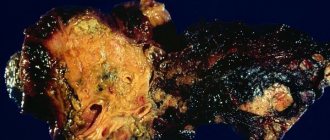When metastases are detected in the liver, the prognosis for life is usually disappointing, but the disease should be fought to the last. Metastases are foci of cancer that have spread beyond the boundaries of the initially affected organ. If liver metastases are diagnosed, the prognosis depends on various factors.
But in general, the seizure of the liver by cancerous nodules is a very strong blow to health and life expectancy: doctors say that, depending on the degree and severity of the disease, a person can live from 6 months to 5 years.
Who is this article for?
The head of the surgical department of the Medicine 24/7 clinic, Konstantin Yuryevich Ryabov, answers these and other questions
Our expert in this field:
Ryabov Konstantin Yurievich
Oncologist-surgeon, endoscopist, head of the department of surgery
Call the doctor
In this article we will speak in simple, understandable, and at the same time scientific language about a very serious problem - the general misconception about the impossibility of further treating cancer if even one metastatic lesion is detected in the liver. This actually criminal delusion has ruined more than one human life.
Therefore, the text below is written specifically for “advanced” patients and their relatives who do not want to sit back and wait for only morphine to help, who want to save the lives of themselves or their loved ones as much as possible.
We hope that this text will be useful to allied doctors - first of all, non-operating oncologists (from among former therapists who have undergone retraining in oncology), chemotherapists in clinics and day hospitals, gastroenterologists, ultrasound diagnostic doctors, computed tomography and magnetic resonance imaging doctors , namely, those who diagnosed “cancer metastases to the liver” and actually put an end to the patient.
If you are a patient, or you are a medical specialist, send us the results of examinations, an oncologist’s report, and a link to an ultrasound scan, video archive of MRI or CT, and we will be happy to advise you. Within 1 day, you will receive a conclusion about the prospects of organ-saving surgery on the liver, or the possibility of performing chemoembolization of cancer foci in the liver. In some cases, we completely remove the diagnosis of “cancer metastasis to the liver,” which turns out to be a liver cyst, a parasitic liver lesion, a consequence of toxic liver damage, and even a benign tumor.
If we give consent to a certain type of intervention - radiofrequency ablation, liver resection, including atypical, chemoembolization, intra-arterial chemotherapy, combined intervention, then we guarantee the result in the form of the patient returning to active work.
When sending your questions, know that I, Konstantin Yuryevich Ryabov, will personally answer them.
How a cancer patient dies - symptoms, stages, condition
The initial stages of oncopathology occur without visible signs of metastases. Then nonspecific symptoms begin to appear:
- weight loss;
- temperature increase;
- development of anorexia;
- liver enlargement.
As the process progresses, the symptoms of liver metastases increase. Typical manifestations of the oncological process:
- pain in the hypochondrium;
- nausea, vomiting, defecation disorders;
- change in color of stool and urine;
- jaundice of the skin, eyes;
- pale skin;
- increase in the size of the spleen;
- skin itching;
- hypoglycemia;
- accumulation of fluid in the peritoneum – ascites.
These symptoms, especially the addition of pain, should alert the patient and become a reason to consult a doctor, even if remission lasts several years.
Stages of death of cancer patients
With any type of cancer, a person fades away in a certain sequence, in which the affected organs and their systems gradually stop working in the body.
Sufferers often experience severe pain, exhaustion and weakness. But death does not occur immediately. Before this, a person has to go through certain stages that lead to biological, irreversible death.
Below are the stages of how a person with cancer dies:
| Predagonia | Agony | Clinical death | Biological death |
| There is a bluish appearance of the skin and a decrease in blood pressure. The patient's nervous system function is sharply depressed. There is a decline in physical and emotional functions. The patient is in the stupor stage. | With its onset, the patient’s respiratory function deteriorates, which leads to severe oxygen starvation in organs and tissues. The blood circulation process slows down greatly until it stops completely. The person is in an unconscious state (stupor, coma). | All organs and organ systems suddenly cease to function. Blood circulation stops completely. | It occurs at the moment when the brain stops working and the body completely dies. |
Is it possible to cure
With such a serious illness and only chemotherapy, only one in six patients can survive a year. Having learned what liver cancer is, many are interested in how long they can live with the disease and such a diagnosis. An increase in life expectancy to five years is even less likely.
A definitive cure is believed to be virtually impossible. Although, medicine knows cases when, despite everything, the development of the disease stopped, the patient lived for more than five years.
Despite the serious condition of the patient, it makes sense to continue treatment of liver cancer at stage 4. The patient’s attitude comes first, because illness is not a death sentence. Therefore, people who have a positive attitude and follow all medical recommendations have the greatest chance of healing.
List of recommended treatment measures:
- analgesics – to relieve the patient’s suffering,
- plasma injection,
- antiemetics,
- surgical removal of the main tumor - if possible, if the body is not too weakened,
- Using chemotherapy, metastasizing lesions are destroyed.
Surgery may also be performed on the intestinal cavity to remove intestinal obstructions, which are sometimes caused by metastases
In any case, it is important to know how to treat stage 4 liver cancer, despite the fact that the prognosis for stage 4 liver cancer is bleak
Death from liver cancer
Tumors of internal organs can arise primarily or as a result of metastasis from a distant or nearby cancer site. Liver carcinoma often manifests as hepato- or cholangiocellular carcinoma. The first type develops directly from its parenchyma, and the second is localized in the bile ducts.
Primary liver cancer is registered 10 times less often than metastatic lesions.
In most cases, cancer cells are transferred to the liver from the prostate, mammary glands, lungs and digestive tract organs (stomach, intestines). Malignant foci of screening can occur when the main tumor metastasizes or are detected during relapse of the disease.
Death from cancer
All cancer diseases progress in stages. The disease develops in four stages. The last fourth stage is characterized by the occurrence of irreversible processes. At this stage, it is no longer possible to save the person.
The last stage of cancer is the process in which cancer cells begin to spread throughout the body and affect healthy organs. A fatal outcome at this stage cannot be avoided, but doctors will be able to alleviate the patient’s condition and slightly prolong his life. The fourth stage of cancer is characterized by the following signs:
- the occurrence of malignant tumors throughout the body;
- damage to the liver, lungs, brain, esophagus;
- the occurrence of aggressive forms of cancer, such as myeloma, melanoma, etc.).
The fact that the patient cannot be saved at this stage does not mean that he will not need any therapy. On the contrary, properly selected treatment will allow a person to live longer and significantly alleviate his condition.
Common causes of death from cancer
One of the main reasons why cancer patients die is late diagnosis of the disease. There is a unanimous opinion among doctors that in the early stages the development of cancer can be stopped.
Scientists have found and proven that for a tumor to grow to the size and stage where it begins to metastasize, several years must pass. Therefore, patients often have no idea about the presence of a pathological process in their body.
Every third cancer patient is diagnosed with the disease at its most severe stages.
When a cancerous tumor is already “in bloom” and gives many metastases, destroying organs, causing bleeding and tissue decay, the pathological process becomes irreversible.
Doctors can only slow down the course of a fatal disease by providing symptomatic treatment, as well as provide the patient with psychological comfort.
After all, many patients know how painful it is to die from cancer and become severely depressed.
Another reason why cancer patients die is the failure of organs due to the growth of cancer cells in them. This process takes a long time and the existing symptoms are joined by newly formed ones.
Patients gradually lose weight and refuse to eat. This occurs due to an increase in the area of germination of old tumors and the rapid development of new ones.
This dynamic causes a decrease in nutrient reserves and a decrease in immunity, which leads to a deterioration in general condition and insufficient strength in the fight against cancer.
Patients and their relatives must be informed that the process of tumor disintegration is always painful and how painful it is to die from cancer.
Features of the flow and classification
In 90% of cases, liver cancer occurs against the background of cirrhosis. Predisposing factors include alcoholism, prolonged inflammation (infectious, autoimmune, toxic hepatitis) and steatosis.
It is not always possible to overcome cancer, but it is quite possible to prolong a patient’s life and improve its quality. To do this, you need to accurately diagnose and begin treatment.
Treatment regimens correspond to the stage of the malignant process. The TNM classification is often used, which includes characteristics of the main tumor, involvement of regional lymph nodes, and the presence of distant metastases. Typically, clinical signs of the disease appear in the second stage, but the patient most often ignores them.
As the cancer progresses and the tumor grows, the patient’s general condition worsens, which prompts him to visit a doctor.
The liver metastasizes to the lymph nodes, diaphragm, bone structures, intestines, lungs and brain with the development of symptoms typical for damage to these organs.
Prediction of how long to live at this level
Predicting life expectancy for a given patient with stage 4 liver cancer is not always easy. Life expectancy is influenced by many factors:
- age - in old people, blood clotting, immune functions of the body and cell regeneration and other features are much weaker than in young patients;
- a history of other diseases - many diseases accelerate the course of cancer, aggravating the general condition of the patient;
- type and nature of treatment measures - without the use of any means and methods of therapy, patients live no more than 1-1.5 years;
- lifestyle – introducing a diet, giving up bad habits and alcohol and other factors increase the patient’s life expectancy.
In general, active therapy can prolong the life of a patient with stage 4 liver cancer by up to 5 years.
Symptoms at the fourth stage
If the disease progresses, you should pay attention to the symptoms of stage 4 cancer in a person. The doctor should order an examination for such a patient
In this case, the following manifestations are typical:
- enlarged liver,
- ascites appears - accumulation of up to 15 kg of fluid in the abdomen,
- metastasis manifests itself: bleeding from the gastrointestinal tract, nose, gums, constant fever,
- skin yellowish, unhealthy color, itching, intoxication,
- decreased diuresis - urine is excreted worse, at the same time there is dehydration,
- hepatic coma,
- attacks of aggression.
All these are symptoms before the death of liver cancer, when a radical cure is considered impossible. In parallel with the destruction of the liver, the process of metastasis to other organs occurs, so other signs are added. In addition to the breakdown of the liver, cancer causes complications - vomiting and coughing up blood, shortness of breath, blood in the urine and stool.
Esophageal carcinoma
Esophageal cancer is a very dangerous disease. At the fourth stage of esophageal cancer, the tumor grows and affects all nearby organs.
Therefore, pain symptoms can be felt not only in the esophagus, but even in the lungs. Death can occur from exhaustion of the body, since a patient suffering from esophageal cancer cannot take food in any form.
Nutrition is provided only through a tube. Such patients will no longer be able to eat regular foods.
Before death, everyone suffering from liver cancer experiences great agony. They vomit violently, most often with blood. Sharp pain in the chest causes discomfort.
Measures to alleviate the condition
The last stage of liver cancer is often near death and is accompanied by emotional, psychological and physical suffering for the patient. Relatives can help the patient using the following measures:
- Develop a menu and make sure your meals are correct. The patient's diet should include purees, cereals, pureed foods, and liquid dishes. If a regular spoon is not suitable, you can use a probe.
- Constantly feed the patient, wetting the lips if necessary. This will prevent dehydration, improving your breathing.
- To prevent the appearance of bedsores, use talcum powder, wipe the patient's body dry after regular washing, turn over on the bed, knead the back and buttocks.
- If bedsores, ulcers or redness do appear, then Desitin and camphor alcohol are used to combat them.
- Several pillows or an elevated head of the bed will make breathing easier for the patient.
- Communicate with the patient more often, reassure him, and encourage him. In moments of delirium or hallucinations, react adequately, excluding conflicts and quarrels.
- Choose the right painkillers and change them as their effect decreases.
- Give sedatives for excessive agitation, outbursts of aggression, and convulsions.
- Perform breathing exercises to prevent pneumonia.
Source: https://medic-help.ru/bolezni-pecheni/kak-umiraut-ot-raka-peceni/
What are cancer metastases to the liver?
Cancer metastases to the liver are secondary foci that develop from screenings of tumor cells of the main, “maternal” tumor, which entered through the blood or lymph and multiplied to the minimum size that can be diagnosed by non-invasive methods - 0.5 mm.
The issue of micrometastases of cancer to the liver is practically not understood in the scientific literature. The liver is affected by metastases with almost the same frequency as the lymph nodes. In almost every third patient with cancer, regardless of the location of the primary tumor, in-depth diagnostics reveal metastatic liver lesions.
The primary sites for cancer metastases to the liver are the following cancers in descending order:
- cancer of the rectum, sigmoid and colon (colorectal cancer), which metastasizes depending on the histological type in 15 to 35% of cases;
- stomach cancer, which metastasizes with a frequency of 17% to 85%;
- pancreatic cancer - an average of 40%; lung cancer - 15–75%;
- breast cancer - 20–65%.
Much less often, metastases of ovarian cancer, cervical cancer, kidney cancer, melanoma and others are found in the liver.
Causes of metastases
Most often, tumors from the gastrointestinal tract, bronchopulmonary system, and mammary glands metastasize to the liver. Less commonly, liver metastases are detected with neoplasms in the skin, esophagus and pancreas, and pelvic organs. Metastases enter the organ often through the portal vein, less often through the lymphatic system or by spreading from neighboring tissues.
Initially, the cancer cell extends beyond the organ affected by the primary tumor. Then it enters the circulatory or lymphatic system, where it is carried into various organs with the flow of lymph and blood. In a vessel of one of the organs, the metastatic cell lingers, attaches to its wall and begins to grow into its parenchyma. This is how metastasis is formed.
Prediction of survival with cancer metastases to the liver
Life expectancy differs with the initial detection of cancer metastases in the liver in the absence of a diagnosis of cancer and with metastases against the background of treatment for already identified cancer.
It is generally accepted, without taking into account the results of histological and immunohistochemical studies of the results of a biopsy of cancer metastasis to the liver, that the life expectancy of a patient with such a diagnosis without treatment ranges from 4-8 to 12 months maximum from the moment of detection of the first metastasis.
With various treatment options for both cancer metastases to the liver and the primary focus of the malignant tumor, life expectancy can be increased to 3.5 - 5 years.
If we take statistics, then life expectancy is absolutely influenced by the source of metastases and, in fact, the course of the main tumor process - in the intestines, pancreas, etc., as well as the gender and age of the patient and the presence of concomitant diseases. According to domestic data, the survival rate of women is higher than that of men.
Only 10-15% of men and 15-19% of women survive to 1 year after diagnosis. Up to 3 years - respectively, 7-10% of men and 10-15% of women. The threshold of 5 years after cancer diagnosis is reached by only 3-6% of men and 9-12% of women. The survival rate of patients with cancer metastases does not depend so much on age. The annual survival rate for people under 50 years of age is 20-25%, for people from 50 to 70 years old it is 10-15%, and for people over 70 years old it is 12-13%.
Survival prognosis
How long people live with cancer metastases to the liver is determined by a complex of factors. Maximum life expectancy in patients with single (solitary) nodes, up to 3 cm in diameter, located in the right lobe of the liver. The minimum duration is in patients with bilobar liver disease, that is, in the right and left lobes, with multiple heterogeneous nodes.
Chemotherapy itself is practically not used to treat metastatic liver cancer. Chemotherapy can increase the life expectancy of patients with cancer metastases to the liver to 1.5-2 years. Moreover, polychemotherapy (PCT) for the primary cancer site and anti-relapse PCT are of particular value.
The main treatment method that ensures long-term survival of patients with cancer metastases to the liver is radical - surgery, chemoembolization, radiofrequency ablation of lesions and other less common methods.
Actually, surgical resection of the liver can be performed due to a combination of factors only in 5-20% of patients with various tumors with metastases to the liver. Chemoembolization and radiofrequency ablation can increase this proportion to approximately 50% of all patients with cancer metastases to the liver. Unfortunately, up to 50% of all patients are forced to settle for palliative or symptomatic treatment.
We actively recommend that in the initial diagnosis of colorectal cancer and single liver metastases, active surgical treatment with simultaneous removal of the primary lesion and metastases. This makes it possible to increase the five-year survival rate to 30-40% of all initially operated patients.
In general, cancer metastases in the liver reduce life expectancy, although they are not a death sentence. We believe that it makes sense to fight with all possible modern methods of treatment. If you don’t give up and do everything possible, then you have a chance to live for many more years!
How effective is the treatment?
There are several types of treatment for malignant tumors:
- surgical intervention;
- chemotherapy;
- combination treatment;
- radiofrequency thermal destruction (destruction of tumor cells under the influence of high temperatures);
- cryodestruction (destruction of tumor cells under the influence of low temperatures);
- injection of ethyl alcohol into the tumor;
- radiation therapy;
- hormonal therapy.
How and which of the above methods to treat liver metastases is determined in each specific case. The most effective is a combined type of treatment, which includes surgery and the use of medications. This method increases the prognosis of patient survival by 50-60% from the initial one.
Treatment of malignant neoplasms includes three stages:
- Stage 1: curative (healing) treatment. At this stage, the maximum possible doses of drugs and surgical intervention are used;
- Stage 2: cancer-specific treatment. At this stage, treatment of liver metastases is aimed at increasing the patient’s life expectancy, preventing the spread of tumors and relapses;
- Stage 3: symptomatic treatment. This treatment helps eliminate residual symptoms of the disease.
Treatment is the main factor determining how long a person will live, so it is important to contact a good specialist who will select an effective course of treatment based on the individual characteristics of the patient.
Causes of liver metastases
The liver is one of the most abundantly supplied organs. Up to 30-40% of the body’s total blood passes through it every minute, on average about 1.5 liters per minute. In this case, approximately 30–35% of the blood enters through the hepatic arteries, and the remaining 70–75% through the portal vein from the intestine. Then both of these flows, mixed, return to the heart through the inferior vena cava.
The liver, due to the specificity of its blood supply, is a place of “retention” of tumor cells, which leads to the most frequent localization of hematogenous tumor metastases in it, regardless of whether the primary tumor is drained by the portal vein system or other veins of the systemic circulation.
In this case, half of the metastases come from primary tumors localized in the abdominal cavity and pelvis, and draining into the portal vein system. Thus, in colorectal cancer, after radical resection of the affected part of the intestine, and subsequently having no relapses in the area of the primary operation, PET-CT reveals single liver metastases in approximately 50% of cases.
In the absence of radical treatment, the average life expectancy of such patients is less than 2 years.
With other gastrointestinal tumors, including cancer of the stomach, esophagus, and pancreas, metastases are detected in approximately 40-50% of patients. In lung cancer, breast cancer, and melanoma, metastases are detected in approximately 30% of patients. Metastases to the liver occur very rarely in cancer of the oral cavity, pharynx, prostate gland, and bladder. Quite rarely, cancer of the uterus and cancer of the ovaries, pharynx, oral cavity, bladder, and kidneys metastasize to the liver.
It is important to note that approximately 2/3 of metastases histologically and immunohistochemically repeat the “maternal” tumor, and a third morphologically differ from primary tumors in the degree of differentiation of tumor cells, which makes it difficult to determine the organ affiliation of the primary tumor.
Treatment of cancer metastases in the liver
Book a consultation 24 hours a day
Diagnosis and treatment of liver metastases in colorectal cancer
Oncology treatment always takes a long time and requires a lot of effort and money. Unfortunately, when metastasis occurs, especially to the liver, the treatment process for intestinal cancer is practically reduced to zero, because secondary lesions are a sign of the last stages of cancer, when treatment does not produce results. Therapy in this case is aimed at relieving painful symptoms.
But there are exceptions when oncology can be effectively treated. Therefore, first of all, you need to seek medical help. After diagnosis and a meeting of the oncologist group, the attending physician decides on further actions.
Modern methods and examination methods are used to diagnose intestinal cancer and liver metastases. First, you need to undergo general blood and urine tests. Secondly, blood donation for tumor markers is required. Thirdly, an ultrasound examination of the abdominal organs and computed tomography are performed. If necessary, magnetic resonance imaging may be performed. Laparoscopy and biopsy are integral procedures in diagnosing intestinal cancer and liver metastases.
After passing all types of examination, the doctor sees the full picture of the disease and draws appropriate conclusions.
If surgical treatment is possible, then the chances of recovery are high. Before and after the operation, a course of chemotherapy is prescribed.
Symptoms of cancer metastases to the liver
If a patient has single cancer metastases to the liver, then in most cases, until they reach a diameter of 5-7 cm or begin to compress the biliary tract, then due to the high regenerative ability of the liver, metastases do not manifest themselves for a long time. In the presence of a primary tumor focus (before radical or cytoreductive surgery), the clinical symptoms of metastases are summarized with the symptoms of the primary tumor.

If we talk about metastases in the liver, the disease can manifest itself with the following symptoms. First of all, this is astheno-vegetative syndrome. The patient loses significant weight while maintaining his diet and appetite; he complains of constant fatigue and a feeling of weakness at any time of the day. Performance gradually decreases.
I begin to worry about constant acute paroxysmal or minor pain in the right side, sometimes accompanied by an unpleasant sensation of friction in the right hypochondrium. The patient complains of uncontrollable nausea and vomiting, bitter belching, diarrhea or constipation. The skin takes on an earthy tint. All manifestations of this syndrome are caused by functional impairment of the biliary and detoxifying functions of the liver, and, in principle, are reversible, provided that the primary factor—cancer metastasis to the liver—is eliminated.
The syndrome of obstruction of the biliary tract develops due to compression of large bile ducts by the tumor mass, primarily the common bile duct and lobar intrahepatic ducts. The patient constantly complains of bursting pain in the right hypochondrium. He begins to be bothered by itchy skin, and the skin acquires a yellowish tint along with the sclera. Spontaneous attacks of fever are observed. Urine takes on a dark (beer) color.
Compression syndrome of the inferior vena cava is accompanied by persistent edema of the lower extremities that does not change during the day, which is accompanied by the accumulation of fluid in the abdominal cavity. The pain becomes diffused throughout the abdomen.
Gradually, the severity of both astheno-vegetative syndrome, biliary tract compression syndrome, and inferior vena cava compression syndrome begin to increase. Decompensation of liver function leads to weight loss up to an extreme degree of exhaustion - cachexia, while there is a deterioration in appetite up to complete refusal of food.
Compression of the biliary tract, and as a result, the development of obstructive jaundice, is accompanied by portal hypertension syndrome with compression of the portal vein. As a result, according to the law of communicating vessels, dilation of the veins of the esophagus, rectum, and anterior abdominal wall (“head of the jellyfish”) occurs, which leads to episodic bleeding from the dilated veins. Small ascites increases in size and can reach a maximum of 20-25 liters, according to our clinical data.
The most dangerous conditions become closer to the end of the disease - persistent vomiting lasting up to a day, especially with scarlet blood, black stools, severe abdominal enlargement, as a rule, indicate gastric or intestinal bleeding that requires emergency surgical care.
To avoid the development of the above-mentioned complications, we recommend regular, at least once a month, control examinations - ultrasound of the liver, and at least once every 3 months, MRI of the abdominal organs with intravenous contrast. This is the only way to achieve prolongation of life with satisfactory health. Late detection ends in the death of the patient.
Symptoms
There are various signs of liver metastases, these include:
- loss of appetite;
- weight loss;
- headaches and dizziness;
- general weakness;
- a bitter taste in the mouth and a yellow color of the tongue, which appear as a result of a violation of the outflow of bile;
- nausea and vomiting;
- heaviness and pain in the right hypochondrium;
- dilated veins in the abdomen during general examination;
- yellowness of the skin;
- presence of a tumor node upon palpation (palpation), etc.
Liver lesions most often indicate advanced stages of the tumor process and require immediate intervention by specialists.
In addition to the listed signs, changes in the general analysis (inhibition of hematopoietic germs) and biochemical analysis (increased bilirubin levels, liver tests) of the blood, and gastrointestinal bleeding may be observed.
Diagnosis of cancer metastases to the liver
In most cases, cancer metastases to the liver are diagnosed during a random examination (for example, during a planned cholecystectomy), less often during an examination to clarify the nature of the lesion in primary cancer of another location.

Typically, studies include non-invasive and invasive examination methods. Among the non-invasive ones, the simplest and most accessible is liver ultrasound, which mainly performs a screening function. However, its resolution does not make it possible to see metastases less than 0.4-0.5 cm in diameter.
Imaging methods such as PET-CT, CT or MRI scans allow you to evaluate their size, quantity, location, growth pattern, detect suppuration and decay, and involvement of neighboring tissues and organs in the tumor process.
However, the diagnosis of micrometastases in the liver area is based on contrast portography, which allows a detailed study of the state of blood flow in the portal vessels. Micrometastases themselves are detected on portograms based on the depletion of the vascular pattern in the area of metastatic formations. With their help, you can notice damage to the vascular bed; the procedure is monitored on a CT monitor.
Invasive diagnosis of cancer metastases to the liver includes performing a liver biopsy, including using a needle (fine-needle aspiration biopsy) or a special instrument - a trephine (core biopsy, trephine biopsy).
It is necessary to dispel the myth that liver biopsy leads to tumor growth or the appearance of peripheral metastases. No results - liver biopsy does not increase the risk of metastasis.
The biomaterial is sent to a specialized laboratory for histological and immunohistochemical examination. On the one hand, 2/3 of the metastases coincide in their histological portrait with the maternal tumor, but 1/3 do not coincide.
All of the above diagnostic methods are available to patients of the Medicine 24/7 clinic.
How are cancer metastases in the liver treated?
The treatment tactics for cancer metastases to the liver are determined by the number of metastases - single or multiple, their localization in the region of the edge of the liver or the porta hepatis, and the histological type of cancer.
In principle, all major treatments for liver cancer metastases include surgery, chemotherapy, radiation, and chemoembolization. The Medicine 24/7 clinic performs all main types of liver surgery - lobar, segmental and atypical resections.

In addition to exclusive liver surgeries, our specialists routinely perform modern minimally invasive liver interventions, including percutaneous transhepatic radiofrequency ablation (RFA), as well as RFA of the liver during laparoscopic and open laparotomy operations.
Treatment of cancer metastases to the liver has certain difficulties. Thus, about 1/3 of all liver metastases are not sensitive to those chemotherapy drugs that are used to eliminate the primary tumor. Therefore, for effective chemotherapy of metastatic liver cancer in most patients, it is necessary to combine chemotherapy and targeted drugs.
Moreover, in many cases of metastatic liver cancer, systemic chemotherapy is ineffective, and intra-arterial chemotherapy must be administered into the hepatic artery. In our clinic, for the purposes of regional chemotherapy for cancer metastases to the liver, implantable venous and arterial port systems are used, followed by regional infusion of chemotherapy drugs. Drugs with proven effectiveness have been registered in Russia for targeted therapy of cancer metastases to the liver.
Chemoembolization of liver cancer metastases is used to treat single and large metastases located near large neurovascular bundles when surgical resection is difficult or impossible. Chemoembolization is carried out using microspheres filled with chemotherapy. Microspheres restrict blood flow in the metastatic node, and the chemotherapy itself, released over a long period of time, leads to necrosis of the tumor tissue.

RFA of cancer metastases to the liver can be used repeatedly for recurrent cancer. Most often it is included in complex treatment.
Radiation therapy for cancer metastases to the liver is practically ineffective, since it does not affect the survival of patients and their life expectancy. It only allows in some cases to reduce the intensity of the pain syndrome.
The main thing that our patients need to know is the ability to achieve a positive treatment result for any type of cancer metastasis to the liver.
How people die from liver cancer: symptoms before death
Liver cancer is a collective term that refers to several types of malignant tumors. The disease has a rapid and aggressive course, without proper treatment it leads to the death of a person within 2-3 months. But active therapy does not guarantee survival. Only 30% of patients can survive up to five years with liver cancer.
Characteristics of the disease
A malignant liver tumor can develop from different parts of the liver. Therefore, there are several types of cancer, depending on what tissue it comes from. Each variety differs in the degree of aggressiveness and speed of development.
Primary and secondary cancer
Primary liver cancer ranks eighth in incidence among all malignant tumors. For example, in Asian countries this is the most common cancer pathology in men. Factors contributing to its development are considered:
- hepatitis B virus infection;
- alcoholism;
- intoxication with aflatoxin, a waste product of mold fungi;
- smoking;
- infestation with opisthorchiasis.
Secondary cancer is metastatic, that is, the main focus is in another organ. This is the basis for the classification of malignant liver tumors.
Primary:
- hepatocellular carcinoma;
- cholangiocellular cancer;
- hepatocholangioma;
- angiosarcoma;
- teratoblastoma.
Secondary:
- sarcoma;
- melanoma;
- carcinoid;
- chorionepithelioma.
It is important to know! A cancerous tumor can grow in the form of nodes, spread to the entire liver tissue, or develop as cirrhosis. Secondary liver cancer occurs 20 times more often than primary liver cancer.
Metastases
One of the signs of malignant tumors is their ability to metastasize. These are cancer cells or pieces of pathologically altered tissue that enter other organs through the blood or lymph. Metastasis is a sign of advanced stage cancer. The spread of a malignant neoplasm is one of the causes of death.
Survival Prognosis
The earlier the disease is detected, the better the prognosis. However, the peculiarity of liver cancer is that at first it is asymptomatic, and then begins to develop at lightning speed. Therefore, the maximum lifespan for this tumor does not exceed five years, even with treatment. Most patients die in the first 2-3 years after diagnosis.
Causes of death
A person dies not only because a tumor grows in his body. By itself, it does not have a significant negative impact. The causes of death from liver cancer are usually complications of the malignant process:
- decay and suppuration of the tumor, leading to the development of sepsis;
- hepatic encephalopathy ending in coma;
- intestinal obstruction due to compression by a tumor;
- massive gastric or esophageal bleeding;
- secondary infections against the background of reduced immunity;
- congestive pneumonia;
- blood clotting disorder.
All these conditions are manifestations of stages 3-4 of the disease.
Symptoms of advanced liver cancer
A stage 3-4 tumor is already considered incurable. Therapy is carried out at this stage, but it is already palliative, aimed at alleviating suffering. A person with advanced cancer develops a pronounced clinical picture:
- exhaustion;
- yellowness of the skin;
- significant enlargement of the liver;
- large belly due to ascitic fluid accumulated in it;
- sallow complexion;
- intellectual disorders due to liver intoxication.
Dysfunction of the organ is accompanied by increased bleeding and changes in hormonal levels.
Ways to relieve suffering
Patients with liver cancer experience great suffering caused by the tumor. These include pain, the inability to perform everyday activities, and psychological problems. A person with advanced cancer needs to take measures aimed at alleviating his condition:
- organization of nutrition through a tube;
- lip wetting;
- wiping the body, brushing the teeth, and, if possible, washing the hair;
- turning the patient in bed every two hours to prevent bedsores;
- elevated position of the head end of the bed to facilitate breathing;
- maintaining consciousness through communication;
- adequate pain relief with narcotic analgesics.
Socialization of the patient is very important. A person needs to feel like a full-fledged member of his family and society. To do this, you need to talk to him as an equal, to dedicate him to all the news of the world around him.
Attention! Elimination of pain is also a mandatory measure. Conventional analgesics in this case do not have the required effect; the prescription of drugs such as Promedol and Morphine is required. They are released from pharmacies only with a doctor's prescription.
Psychological state of the patient before death
In cancer patients, especially in the last stages, their worldview changes significantly. They evaluate life differently, treat loved ones differently.
A person can be self-absorbed, or, conversely, show increased vital activity. These social changes depend on the patient's age, experience, social status, education, and many other factors.
It is impossible to predict in advance what the condition of a cancer patient will be; everyone experiences this disease in their own way.
Many people do not realize the criticality of their situation until the very end and try to lead an active lifestyle. When severe weakness develops, such a person falls into a state of depression because he cannot engage in usual activities. Often people become embittered and aggressive. Hepatic encephalopathy, which changes the character and intelligence of the patient, is also important.
There are people who, after the diagnosis is announced, become depressed and lose their zest for life. This accelerates the development of cancer and worsens the prognosis. It is extremely rare to encounter patients who adequately perceive their diagnosis and follow all medical recommendations.
Death symptoms
Cancer is a disease that is extremely rarely curable today. Many patients die from the rapidly growing tumor. The near-death state can last a long time, or it can be lightning fast. How people die from liver cancer can be seen from the characteristic symptoms.
- Constant drowsiness, being in a stupor. This condition is caused by inhibition of brain activity due to intoxication. The liver can no longer perform a neutralizing function, so the brain is affected by various waste substances. This condition is also called hepatic encephalopathy.
- Lack of appetite. It is also caused by intoxication, as well as severe weakness and intense pain.
- No movement. Exhaustion leads to the fact that a person not only stops performing daily activities, but cannot even get out of bed.
- Mental disorders. Again associated with brain damage from toxins. The patient's speech becomes slow and slurred. He stops recognizing close people and is not oriented in place and time. Hallucinations may develop.
- Respiratory disorders. They are caused by the accumulation of fluid in the lungs, as a result of which a person experiences attacks of suffocation and moist rales.
- Urinary disorder. Associated with a small volume of fluid intake and low physical activity.
It is important to know! When such signs of death appear in liver cancer, life expectancy is already calculated in days or hours.
Stages of condition before death
Liver cancer symptoms before death can be divided into several stages. In each of them, certain changes occur in the body, ultimately leading to death. All of them are theoretically reversible, but in practice death usually occurs.
- Predagonia. Severe drowsiness, lethargy, loss of orientation. A dying person stops talking, moving, and eating. The skin turns pale and has a bluish tint. Blood pressure decreases and urination stops.
- Agony. There is a complete loss of consciousness. Symptoms include a lack of response to any irritants, deep, rare breathing, a slow pulse and low blood pressure. All these are signs of hepatic coma. The skin is bluish, the sphincters relax - the bladder and rectum are emptied.
- Clinical death. Lack of breathing, consciousness and pulse. This condition is still reversible within 5-7 minutes.
Then comes biological death - irreversible suppression of vital functions.
Liver cancer causes death very quickly, within a few years. Against this background, all body functions are suppressed, immunity is reduced, which together leads to death.
Patients in the final stages of the disease lose the ability to even self-care, so they need careful care. Psychological support for such patients is also extremely important.
To alleviate the pre-death state, there are special hospices.
Source: https://gepatologist.ru/bolezn/zlokachestvennoe-novoobrazovanie/kak-umirayut-ot-raka-pecheni.html
Prognosis for cancer metastases to the liver?
The most common question that we are asked by relatives of patients admitted to the Medicine 24/7 clinic with cancer metastases to the liver is “does it make sense to treat metastases in the fourth stage of cancer”, “is it necessary to operate on the patient”, “what is the prognosis for life and outcome of treatment"? The outcome of treatment is determined by the genetic profile of the tumor, the degree of tumor differentiation, and the location of the primary tumor.
In general, it is important to know that after the initial detection of liver metastases, patients live on average for 6-18 months. Life expectancy is slightly higher in patients with primary colon cancer with liver metastases. With comprehensive patient management, with radical or cytoreductive interventions, the life expectancy of patients can be up to 2.5 years. If during a PET-CT or CT scan of the body cancer metastases are detected in the bones or brain, the prognosis sharply worsens.
Our oncologists and surgeons at the Medicine 24/7 clinic have significant experience in the complex treatment of cancer metastases to the liver and primary tumors. Therefore, in many cases we can guarantee a significant improvement in the quality of life, and in some cases, a significant prolongation of life. The greatest effect is achieved with highly differentiated metastases of well-differentiated adenocarcinoma of colon cancer. In the case of such patients, the life extension as a result of treatment is about 3-5 years. It is important to combine this intervention with cytoreductive surgery to remove the primary tumor site.

If liver metastases are caused by primary cancer of the lung, pancreas, stomach and other organs, then resection of liver metastases is not so critical for determining the prognosis of patient survival. However, economical resection, RFA of single nodes, and chemoembolization can reduce the toxic load on the liver and make it possible to carry out chemotherapy for the primary cancer.
If the patient’s follow-up examination reveals multiple foci in the liver and lymph nodes, the prognosis is significantly worse, it is generally negative. In most of these cases, it is impossible to radically help, but it is possible to preserve the quality of life of patients through complex blood purification procedures (plasmapheresis and hemosorption).
IMPORTANT: statistics show that if by the end of the first year after the first cancer metastases are detected in the liver, the patient still has the strength to continue the fight, then the likelihood of living another 2-5 years increases significantly.
How long do such patients live and how to prolong life?
The average life expectancy with diagnosis is 12-18 months. However, you need to understand that the average statistics for a particular case provide little useful information for several reasons:
- Some people live no more than a few months or even weeks, while others live for many years after treatment.
- The probability of survival is devoid of randomness. The lifespan depends entirely on the extent of the lesion, the skill of the surgeon, the age and gender of the patient, and his psychological state.
- Since liver cancer is usually metastatic in nature, the location of the primary tumor has a great influence.
- Statistical data is collected for the past period, sometimes 10-15 years pass after the statistics, which is a very long time for medicine. Thanks to new drugs and medical equipment, you can live longer.
Without treatment, patients survive on average for about six months. Thanks to effective treatment and fasting diets, life is extended to a year or a year and a half. For example, successful surgery increases the five-year survival rate to 30-40%.
Although chemotherapy is not carried out directly to treat liver metastases, it cannot be abandoned, since it is necessary to eliminate the initial source of cancer cell spread. Thus, chemotherapy affects survival, prolonging it by 1-2 years.
In addition to treatment, survival is influenced by the nature of metastasis. If, after treatment, the primary focus of cancer cells is removed along with the metastasis in the liver, then a person has a high chance of living 5 years or more. If a relapse develops, the chances of survival are very low.
How to extend life?
Some folk recipes will increase your chances:
- 25 g of hemlock are poured with 500 ml of 40% vodka. You need to insist for 40 days in a place deprived of light. The tincture needs to be shaken periodically. After the expiration of the period, the product is filtered and drunk according to the following scheme: the first day - a drop, then 2, later 3, and so on, increasing up to 40 drops. Dissolve in 100 grams of water.
- Pour 0.5 liters of hot (not boiling!) water into a thermos. A tablespoon of potato flowers goes there. You need to insist for 4-5 hours. Then you need to strain and drink 100 ml 3 times a day. The tincture should not be stored in a thermos, but in a cool place.
- Wipe the celandine head and pour 500 ml of 70% alcohol. You need to insist for 24 hours, then strain and take 25 ml once a day for a week, and then 50 ml per day for 20 days.
There are several dietary recommendations for liver cancer:
- red fruits and vegetables, especially pomegranate and blueberries;
- green tea;
- berries: raspberries, strawberries, wild strawberries.
It is prohibited to consume the following products:
- meat and fatty foods;
- mushrooms;
- beans, peas, other legumes;
- confectionery;
- canned food;
- chocolate and cocoa;
- bakery products;
- pickled, salted, pickled cucumbers and cabbage;
- full fat milk;
- fried and smoked foods.
Complications during combined treatment of cancer metastases to the liver?
Against the background of repeated metastasis of the lesion or recurrence of the primary cancer in the liver, the growing tumor tissue compresses the intrahepatic bile ducts, portal vein, and inferior vena cava. As a result, the existing signs of hepatic jaundice are complemented by obstructive jaundice, which leads to brain damage. A negative aspect of the development of obstructive jaundice is the inability to continue treatment - chemotherapy and surgery.
In this case, surgical restoration of the patency of the bile duct is performed using a temporary scheme - using percutaneous transhepatic stenting, or a permanent scheme - using retrograde stenting of the common bile duct under endoscopic control. In the first case, the bile flows out into the bile receptacle. In the second case, bile enters the intestinal lumen.
Percutaneous transhepatic stenting is performed in the X-ray operating room, under X-ray control of the C-arm. The interventions themselves are performed by x-ray endovascular surgeons with extensive experience in Russian state x-ray surgery centers.
Retrograde endoscopic stenting is also performed in the X-ray operating room with simultaneous X-ray (C-arm) and endoscopic control. The interventions themselves are performed by endoscopists who have surgical skills and have been trained in various techniques for stenting the biliary tract.
We will call you back
Effective methods for treating metastatic liver cancer - atypical resections, radiofrequency ablation, chemoembolization
What happens to the liver after removal of metastases?
When cancer metastases in the liver are removed non-invasively - using chemoembolization, radiofrequency ablation or radioembolization - a zone of necrosis is formed and then replaced by a scar. This process usually takes from 2 to 6 months. The scar is sometimes significant and forms a dense cord or knot up to 2-4 cm in diameter. It can compress the internal bile ducts.
When removing cancer metastases to the liver non-invasively - using the surgical method, the scar is usually thread-like. Complete restoration of the size and structure of the liver after major resections is observed after 3-6 months. In a healthy person, the liver can restore its full volume from the remainder after surgery in the amount of 20% of the original.
In the case of massive resections in cancer patients with reduced regenerative capacity, recovery occurs within 6-8 months. and, in the limit, from a stump measuring 30% of the original size of the liver.
Where to treat cancer metastases to the liver: abroad or in Russia?
“The diagnosis of stage 4 cancer” is made already in the presence of a single cancer metastasis to the liver. For almost every patient, such a diagnosis—“cancer with metastases to the liver”—sounds like a death sentence. Having received it, many Russian patients refuse any treatment and stop fighting. Very few choose the path of struggle and go abroad.
In fact, in Russia, in Moscow, specifically, at the Medicine 24/ clinic, all modern technologies and drugs for the treatment of cancer metastases of any origin are available. We believe that a patient can always be helped, even if he cannot be cured radically. That is why we undertake the treatment of patients with cancer at any stage. Our specialists have accumulated many years of experience in managing palliative patients with various stages of cancer in almost any location, including those previously treated abroad, in Germany, Israel, Switzerland and the USA.
How will the consultation with an oncologist-surgeon go?
IMPORTANT: We ask our patients not to become doctors, not to try to create and implement an examination program on their own: we do not use the results of radiography, liver ultrasound, or plain radiography. Your individual program of examination and preparation for surgery will be developed by our oncologist-surgeon personally or as part of a consultation.
Fundamentally, during a preliminary consultation, the presence of a primary lesion or its recurrence, the relative location of metastases, and the prospects for conservative and surgical treatment are determined.
One of our know-how in determining the feasibility and possibility of achieving results after surgery in patients with cancer metastases in the liver is the combined performance of high-resolution CT and MRI on the same day. The combined implementation of both studies gives the oncologist-surgeon a complete picture of pathological changes in the liver, and makes an informed choice in the treatment regimen.











